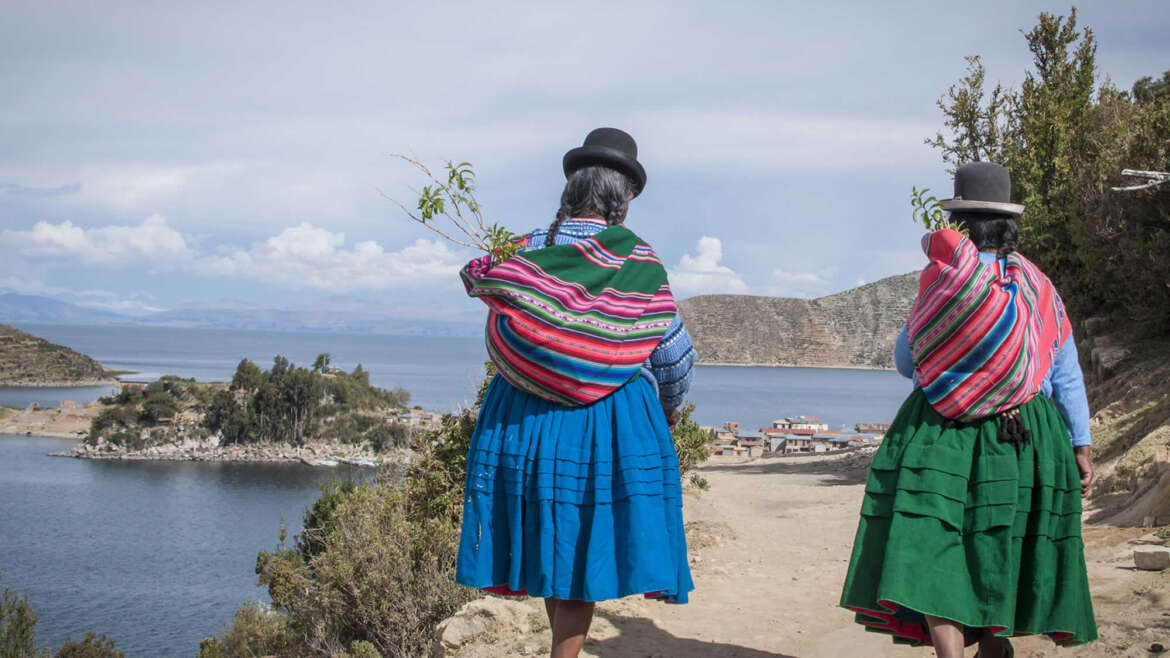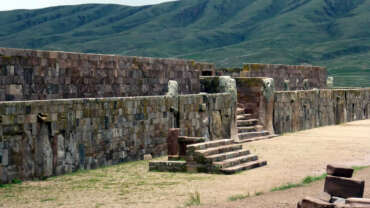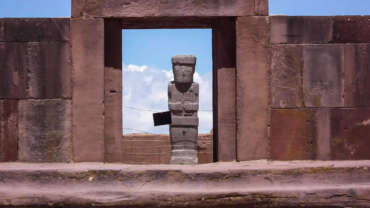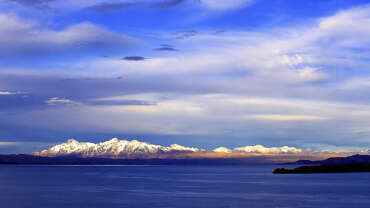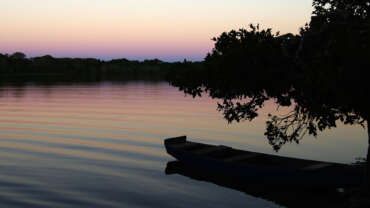Experiences in Bolivia
Lake Titicaca, the ciy of La Paz and the surreal Salar de Uyuni are the best known and most visited attractions in Bolivia, but there are also other, less famous hidden gems for those willing to stray from the beaten track: the jungle and pampas in Rurrenabaque, the imponent Sajama peak and the world’s highest forest, colonial Sucre, the lavish carnival in Oruro and the still thriving Jesuit Missions in the Chiquitania.
Tourist Attractions in Titiaca
Lake Titicaca
The Titicaca Lake is the highest navigable lake in the world with an average height of 3,810 meters above the sea level. The Titicaca Lake is a great tourist attraction for nature lovers. A portion of lake Titicaca belongs to Bolivia and the other one to Peru.
Copacabana
Copacabana is a small town located on the Bolivian shore of Lake Titicaca. This is the original Copacabana and a popular resort destination for travelers.
Island of the Sun
The Island of the Sun is located on the Northwest end of the peninsula of Copacabana, Bolivia. The Island of the Sun has several ancient monuments – The Pilkokaina Palace and the Chinkana or Labyrinth, The Stairway of the Inca, Sacred Fountain Youth and the Incas’ Terraces.
Island of the Moon
The Island of the Moon (Koati) is located at 7 Km. from the Island of the Sun. The ruins of the Inak Uyu (Palace or Temple of the Moon) are found here.
Huatajata Community
Huatajata is an indigenous aymara community conformed by 11 communities and it’s one of the most important tourist areas in the occident of Bolivia.
Gold Museum
The small museum in Challapampa displays Inca treasures, ancient pottery and some metal objects discovered underwater off the island. Many come from Johan Reinhard’s underwater research near the northern end of the island, others have been donated by the people of Challapampa.
Chincana Labyrinth
About 300 meters southwest of Titikala (Roca Sagrada or Sacred Rock) is an elaborate Inca ruin called the Chincana (the Labyrinth). Also named the Palacio del Inca, or El Laberinto, or labyrinth, these ruins on the top of Isla del Sol form the complex of the Titicaca, or sacred rock.
Tourist Attractions in La Paz
La Paz City
La Paz is the administrative capital of Bolivia. Altitude of the city ranges from about 4058 meters (13,313 feet) above sea level in El Alto (where the airport is located) to 3100 meters (10,170 feet) in the lower residential area. It is the highest national capital in the world.
Tiwanaku
The ruins of Tiwanaku are found near the south-eastern shore of Lake Titicaca, about 72 km (44 miles) west of La Paz, Bolivia. Tiwanaku is a recognized World Heritage Site.
Apolobamba National Park
The National Park Apolobamba is located to the West of La Paz, Bolivia and has a fantastic scenic beauty because of the snow-covered high mountains: Akamani, Presidente and Katantika.
Cotapata National Park
The National Park Cotapata is located to the Northeast of La Paz, Bolivia. One of its greater attractions is the pre-Colombian road of the Chucura or Choro or Inca Road.
Chacaltaya
Chacaltaya is the highest skiing area of the world. The Chacaltaya mountain (5,580 meters), is one of the mountains of the Cordillera Real (Royal Mountain range) of the Oriental Andes and it is only at 36 kilometers from La Paz, Bolivia.
Cathedral and Plaza Murillo
Plaza Murillo in La Paz, Bolivia, holds the Presidential Palace, and in the center of Plaza Murillo, opposite, stands a statue of President Gualberto Villarroel. The Cathedral was built in 1835 on a steep hillside and the main entrance is 12m higher than its base on Calle Potosi.
Witches’ Market
The Witches Market is one of the main and most impressive attractions in La Paz, Bolivia. The Witches Market has shops of typical outfits made by hand with completely natural materials, souvenirs and other ornaments made of exotic types of wood, carved with ancestral motives.
Huatajata Community
Huatajata is an indigenous aymara community conformed by 11 communities and it’s one of the most important tourist areas in the occident of Bolivia.
Calle Jaen
Calle Jaen in La Paz, Bolivia has been preserved from its Spanish days, and is home to 10 interesting museums clustered together. Calle Jaen is La Paz’s finest colonial street, and the museums can easily be bundled into one visit.
Moon Valley
The Valley of the Moon is located at about 5 kilometers from La Paz, Bolivia. The scenery is formed by rocky formations, which gives an eerie sensation of being on another planet or the moon.
Illimani
Illimani is the highest peak (6,438 metres or 21,122 ft) in the Cordillera Real (part of the Cordillera Oriental, a subrange of the Andes) of western Bolivia. It lies just south of La Paz at the eastern edge of the Altiplano.
Casa de Murillo
Once the home of Don Pedro Domingo Murillo, a leader in the La Paz Revolution of July 16, 1809, in Bolivia, the Casa de Murillo displays collections of colonial art and furniture, textiles, medicines, musical instruments and household items of glass and silver that once belonged to Bolivian aristocracy.
Coca Museum
The Coca Museum in La Paz, Bolivia explores the sacred leaf’s role in traditional societies, its use by the soft-drink and pharmaceutical industries and the growth of cocaine as an illicit drug.
La Paz Cemetery
In La Paz Cemetery, as in most Latin American cemeteries, bodies are buried in the traditional Western way or placed in a crypt.
Iglesia de San Francisco
The hewed stone basilica of San Francisco in La Paz, Bolivia, reflects an appealing blend of 16th-century Spanish and mestizo (indigenous-Spanish) trends. The cloisters and garden of the recently opened Museo San Francisco, adjacent to the basilica, beautifully revive the history and art of La Paz’s landmark.
16 de Julio Market
When visiting La Paz, Bolivia, for an excellent market experience don’t miss the massive Mercado 16 de Julio, which stretches for many blocks along the main thoroughfare and across Plaza 16 de Julio. This shopaholic’s paradise has absolutely everything, from food and electronics, to vehicles and animals.
Mercado Negro
The Mercado Negro in La Paz, Bolivia, is the place to pick up undocumented merchandise, much of it bootlegged, and just about anything else you may hope for.
Flower Market
The Flower Market in La Paz, Bolivia, appropriately located opposite the cemetery at the top of Batista, is a beautiful splash of color amid one of the city’s drabber and less safe areas.
Tourist attractions in Uyuni
Uyuni Salt Flats
The Salar de Uyuni in Bolivia was formed by the disappearance of an inland ocean that covered most of the Altiplano and extended all the way to the Titicaca lake. It is an extraordinary experience to cross this lake of salt by car.
Green Lagoon
Green lagoon (Laguna Verde) is a high-altitude mineral lake in the Eduardo Avaroa Reserve, known for its beautiful green color.
Red Lagoon
The Red lagoon (Laguna Colorada) is a shallow lake within the Eduardo Avaroa Andean Fauna National Reserve and close to the border with Chile. The lake is famous for its strong red colour caused by algae that provide food for large flocks of pink flamingos.
Rock Tree
The Rock Tree (Árbol de Piedra) is a tree-like rock formation in the Siloli Desert desert that offers great photo opportunities!
Salvador Dalí desert
is characterized by landscapes that resemble surrealist paintings by Salvador Dalí.The Salvador Dalí Desert (Desierto Salvador Dalí)
Colchani village near Uyuni
Colchani, Bolivia is also called Puerto Seco (Dry Port) and represents the main access to the Salt Flat due to its location just on the border of the Salar de Uyuni. In Colchani you will find a Salt Factory where visitors can see a rudimentary way to extract and process salt.
Polques Hot Springs
The Polques hot springs are well-known because of the intense volcanic activity in the area. Early in the morning tourists enjoy a bath in these healing waters.
Town of Uyuni
Uyuni in Bolivia is a small town situated in the middle of nowhere. Tourism is its main source of prosperityt hanks to the the world’s biggest Salt Flats.
Cementerio de Trenes – Train Graveyard
The Train Graveyard opens a door to Uyuni’s past when the mining industry collapsed, partly due to mineral depletion. Many trains were abandoned thereby producing the train cemetery – a peculiar tourist attraction very different from the beautiful landscapes of the area.
Town of San Pedro de Atacama in Chile
The town of San Pedro the Atacama is set in an oasis inside the San Pedro de Atacama desert at 2440 m.a.s.l. and 1.670 kilometers away from Santiago de Chile. It is the gateway to the biggest salt flat in the world: the Uyuni Salt Flat in Bolivia.
Andean Fauna
The Andean fauna populating the surroundings of the Uyuni Salt Flat and the amazing lagoons is diverse and rich.
Incahuasi Island
Set on the remains of a volcano, Incahuasi Island, was used as a resting place for the Incas who used to cross the salt flat with llamas.
Thermal waters and geysers
At about an hour from the Red Lagoon in Bolivia there are several geysers. This endless supply of water is spitted out of the ground at a temperature of 90 C, through fumaroles and cracks through which sometimes even volcanic lava erupts.
San Cristobal town
Community located 900 km far from Uyuni. The town is near by the San Cristobal silver mine, one of the biggest in the world.
Licancabur Volcano
Guardian of the Verde Lagoon the Licancabur Volcano is very popular among tourists due to its similarity to Mars. The NASA has been making studies about the volcano reason why it captures more attention and interest.
Ollague Volcano
Ollague let to enjoy a panoramic view of Ascotan and Carcote Salt Flats. The volcano has a crater of 1250 square meters from where displays fumarolic activity, particularly to the south of its summit area but no historical eruptions have been confirmed from Ollague. The volcano also contains a deictic summit lava dome.
Tunupa Volcano
The Tunupa Volcano (Volcan Tunupa) is located at the Daniel Campos province in the Oruro department. The volcano has a height of 5432 meters and can be seen from the entire Uyuni Salt Flat. The Tunupa’s Volcano area is home of different fauna species like flamencos, ostriches and foxes.
Tourist attractions in Santa Cruz
Jesuit Missions
The Jesuit missions in Bolivia have remained intact and even after hundreds of years they continue to marvel the visitors. They are located on the eastern lowlands of Santa Cruz, Bolivia, at about 6 hours from the city.
Noel Kempf Mercado National Park
The National Park Noel Kempf Mercado in Santa Cruz, Bolivia has been declared Natural Patrimony of the Humanity by UNESCO. The Noel Kempf Mercado park presents an exceptional scenic beauty thanks to large farallones and water falls of the Caparu plateau.
San Jose de Chiquitos
This Jesuit settlement is the oldest in the area and is very similar to the North Argentinean or Paraguayan missions, However these last missions are now ruins or museums, while San Jose church still celebrates mass and hosts a very active music school.
Amboro National Park
The National Park Amboro in Bolivia presents a great scenic beauty: deep valleys, the torrential rivers and the water falls. It is located to the West of Santa Cruz, among the Ichilo, Manuel Maria Caballero, Florida and Andres Ibanez provinces.
Metropolitan Cathedral
The Metropolitan Cathedral of Santa Cruz was built by Brother Mercedario Diego de Porres during the times of the Spanish Viceroy Toledo. The Metropolitan Cathedral in Santa Cruz is remarkable for its wooden vaults and for the pictorial decoration that covers them.
Boat trip in the Amazon region
The Reina de Enin Ecological Cruiser is a riverboat that navigates on the Mamore River, the largest river in Bolivia, and a tributary of the Amazon River. The cruiser offers 2-6 day tours during which time you will be in close contact with wildlife and nature.
La Chiquitania
La Chiquitania in Santa Cruz, Bolivia, is a vast and extraordinary territory in which we are able to admire churches of the Jesuit period and where we find wonderful wood carvings and equally beautiful paintings of saints and scenes of religious life.
Valle Grande
Vallegrande is a small town in Bolivia, located in the Department of Santa Cruz. It was here in Vallegrande, over 40 years ago, that the corpse of Ernesto Che Guevara lay on display in the hospital laundry.
Cotoca Sanctuary
Cotoca is a small town of Guarani origin located to the East of Santa Cruz in Bolivia. The Sanctuary of the Virgen de Cotoca, a parrish run by Dominican priests, is a beautiful colonial-style church located on the central plaza.
Los Espejillos
Los Espejillos is a remote tropical paradise in Santa Cruz, Bolivia. With its sparkling waterfalls and natural pools it is truly a wonder of nature. A series of waterfalls have carved out and filled several deep pools as they cascade downward in step-like fashion, each flowing into the next.
Montero
Montero is a city in Santa Cruz, Bolivia. Montero has an elevation of 300 meters above sea level and an average temperature of 23 C. The city is predominantly agricultural, producing soybeans, cotton, corn and rice.
Tourist attractions in Sucre
Villa Abecia
On the road to Tarija in Bolivia is Higuerayoc or Abecia Village. This valley is ideal for grapevine production and the bathing results have amazingly clean and pure water which attract a lot of visitors.
Tarabuco
Tarabuco is located at 60 Km. from Sucre, Bolivia. Tarabuco has a very colorful Sunday fair where local residents exhibit outfits, helmets and ponchos of various colors, designs and patterns.
Casa de la Libertad
On August 6, 1825, the freedom fighters of Bolivia assembled in the Casa de la Libertad to declare independence from Spain. You can visit the exact same room where the liberators met. The first Bolivian congresses were held in the Salon de la Independencia, originally a Jesuit chapel.
Glorieta Castle
The Castle of la Glorieta in Sucre, Bolivia, is a unique attraction which used to belong to Don Francisco de Argandona. The Castle of la Glorieta was constructed towards the end of the XIX century and exhibits various architectural styles – Mudejar or Mohammedan Style, neoclassic, baroque and neo-gothic.
Chuquisaca Prefecture
For the best view of Sucre, Bolivia, climb up up to the cupola of the wedding cake-like building of the Prefectura de Chuquisaca, next to the cathedral.
Catedral Basilica
The Cathedral in Sucre, Bolivia dates from the middle of the 16th century and is a harmonious blend of Renaissance architecture with later Baroque additions. The Catedral Basilica is considered to be the most valuable religious monument of Sucre.
Parque Bolivar
Parque Bolivar (Bolivar Park) in Sucre, Bolivia, is an open-air park which has an interesting collection of miniature replicas of famous French monuments such as the Eiffel Tower, the Arch of Triumph and the Obelisk of Buenos Aires. Parque Bolivar is the Sucre’s favourite lovers’ hangout.
Sucre General Cemetery
The general cemetery in Sucre, Bolivia, is one of the best options to go and learn a bit more about the life of known historical and political figures of the past, whose remains rest at this important landmark.
University of San Francisco
The University of San Francisco in Sucre, Bolivia, was founded on March 27th, 1624 by Padre Juan de Frias Herran.
Quila Quila
Quila Quila near Sucre, Bolivia, is and old colonial style town that has strong Pre-Hispanic roots,located at a height of 3,100 meters above the sea level. The streets have been built on straight angles and are surrounded by homes made of mud and roofs made of straw.
Dinosaur footprints
At 5 kms from the city of Sucre in Bolivia lies Cal Orcko, a giant 80 meters hight and 1.2 kilometers long wall that has petrified footprints of dinosaurs. Cal Orcko is one of the most important pre-historic findings in the world.
Villa Serrano
‘Villa Serrano’ (Serrano Village) near Sucre, Bolivia, is known for the unique way in which its inhabitants celebrate Christmas. Aside from this colorful festivity, this town is well-known for the production of some of the finest charangos (small guitars invented in Bolivia).
Padilla
The traditional Carnival and the archaeological remains of the surrounding areas, make the town of Padilla in Bolivia one of the main tourist attractions of Chuquisaca.



